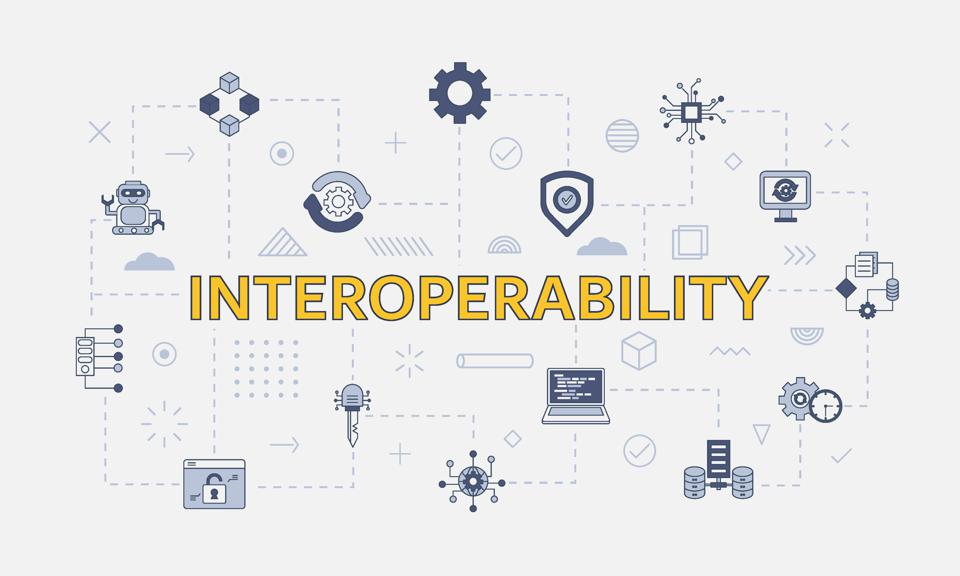Interoperability in Blockchain: Connecting Disparate Networks

Executive Summary

Interoperability, the ability for different blockchain networks to communicate and share data, is a crucial element for the advancement and widespread adoption of blockchain technology. By unlocking interoperability, we can harness the full potential of blockchain to transform industries, foster innovation, and create a more interconnected and efficient digital ecosystem.

Introduction
Blockchain technology has gained significant traction in recent years, offering a secure and decentralized way to record and track transactions. However, the proliferation of different blockchain networks has created a fragmented landscape, limiting the potential impact and scalability of individual networks. Interoperability addresses this fragmentation, enabling the exchange of data and value across different blockchain platforms.
Benefits of Interoperability
Enhanced Efficiency: Interoperability reduces the need for intermediaries and manual data reconciliation, streamlining processes and reducing operational costs.
Increased Adoption: By connecting disparate networks, interoperability makes blockchain technology more accessible and appealing to a broader range of businesses and individuals.
Data Collaboration: Interoperability allows businesses and organizations to share data across different platforms, enhancing data analytics, research, and innovation.
Scalability and Growth: By enabling communication between networks, interoperability expands the reach and scalability of blockchain solutions, fostering the growth of new applications and services.
Increased Security: Interoperability strengthens the overall security of blockchain networks by allowing for cross-validation and detection of malicious activities across multiple platforms.
Key Subtopics
Cross-Chain Technology
Cross-chain technologies facilitate interoperability by enabling data and value transfer between different blockchain networks. Examples include atomic swaps, blockchain bridges, and sidechains.
4 Key Considerations:
- Security: Ensuring that cross-chain transactions are secure and protected from vulnerabilities.
- Efficiency: Optimizing transaction times and minimizing gas fees to ensure usability and cost-effectiveness.
- Scalability: Handling high transaction volumes and supporting future growth of the interconnected networks.
- Governance: Establishing clear rules and mechanisms for cross-chain interactions to ensure transparency and accountability.
Smart Contract Compatibility
Interoperability requires the ability for smart contracts deployed on different blockchain networks to interact and execute seamlessly. This involves ensuring compatibility of programming languages, virtual machines, and data structures.
4 Key Considerations:
- Syntax and Semantics: Defining common syntax and semantics to facilitate inter-contract communication and data exchange.
- Execution Environment: Establishing compatible execution environments across networks to ensure seamless smart contract execution.
- State Synchronization: Maintaining consistency of contract state across multiple networks to provide reliable and accurate data access.
- Composability: Enabling the composition of smart contracts across different networks to create complex and feature-rich applications.
Data Interoperability
Data interoperability ensures that data stored on different blockchain networks can be accessed, processed, and analyzed in a consistent and comprehensive manner. This requires standardization of data formats, indexing, and query mechanisms.
4 Key Considerations:
- Data Standards: Developing common data standards and ontologies to facilitate data exchange and interpretation.
- Data Access: Providing mechanisms for authorized entities to access and retrieve data from different blockchain networks.
- Data Privacy: Implementing data protection measures to ensure the privacy and confidentiality of sensitive data.
- Data Querying: Supporting efficient data querying and analysis across multiple blockchain platforms.
Blockchain Interoperability Standards
Standardization is crucial for ensuring interoperability between different blockchain networks. This involves developing common protocols, APIs, and data formats that facilitate seamless communication and data exchange.
4 Key Considerations:
- Protocol Standardization: Establishing consensus on protocols for cross-chain communication, data transfer, and smart contract interaction.
- API Standardization: Defining standard application programming interfaces (APIs) to provide a consistent way for applications to interact with blockchain networks.
- Data Format Standardization: Standardizing data formats to ensure compatibility and interoperability of data stored on different blockchain platforms.
- Governance: Creating clear governance mechanisms to manage the standardization process and address emerging issues.
Interoperability Use Cases
Interoperability enables a wide range of use cases that demonstrate its transformative potential:
- Cross-Border Payments: Seamless transfer of funds across borders without the need for intermediaries, reducing fees and delays.
- Supply Chain Management: Tracking the movement of goods throughout complex supply chains, ensuring transparency, efficiency, and provenance.
- Healthcare Data Sharing: Secure and controlled exchange of patient data among healthcare providers, improving diagnosis, treatment, and research.
- Decentralized Finance (DeFi): Interoperability connects different DeFi protocols, enabling the creation of innovative financial products and services.
- Digital Identity: Creating a unified digital identity across different platforms, simplifying authentication and reducing fraud.
Conclusion
Interoperability is the key to unlocking the full potential of blockchain technology. By connecting disparate networks and enabling data and value sharing, it fosters innovation, drives adoption, enhances efficiency, and strengthens security. As interoperability solutions continue to evolve and mature, we can expect to see the transformative power of blockchain extend across industries, creating a more interconnected, efficient, and transparent digital landscape.
Keyword Tags
- Blockchain Interoperability
- Cross-Chain Technology
- Smart Contract Compatibility
- Data Interoperability
- Blockchain Interoperability Standards
